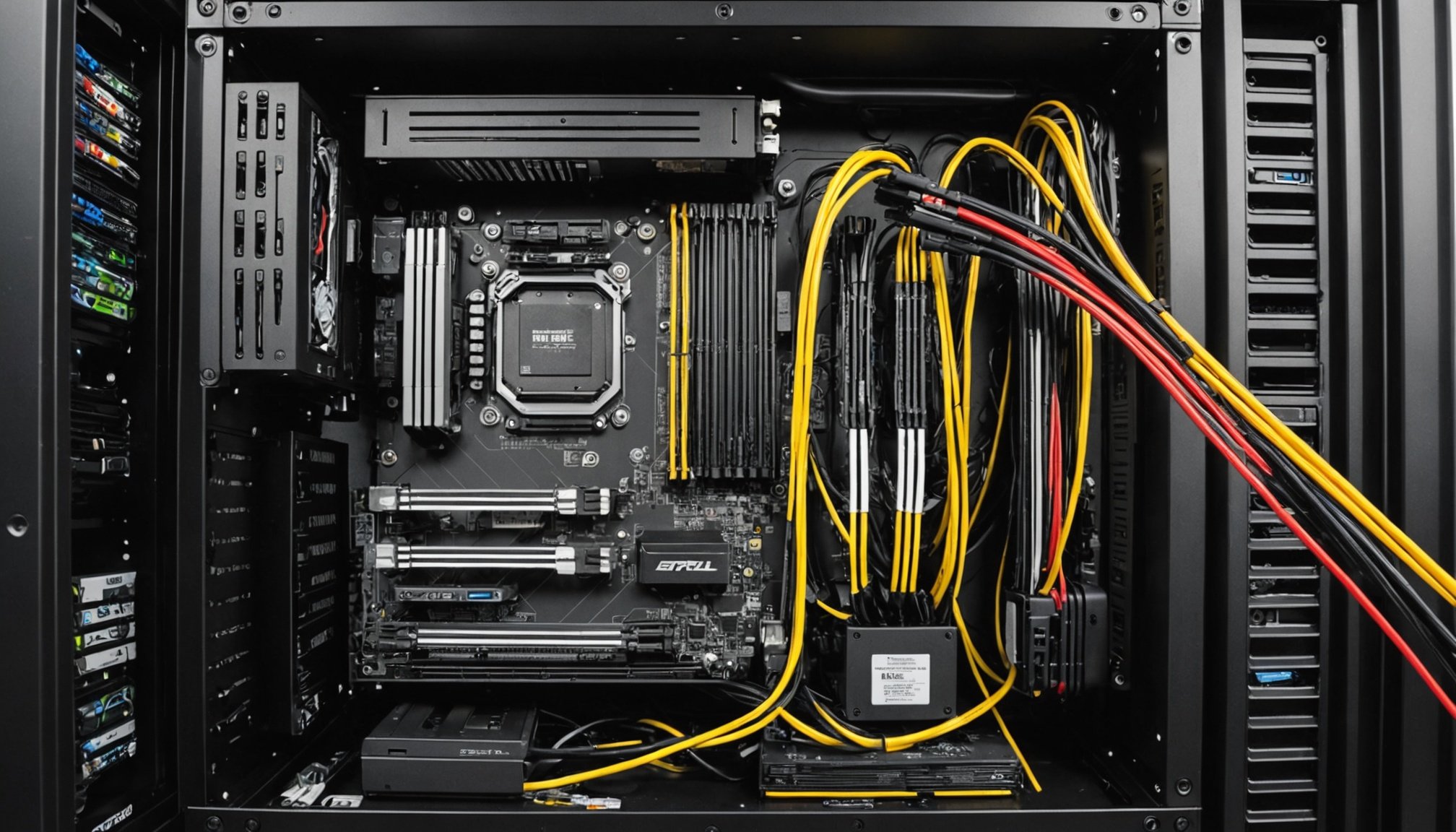Top Tips for Expert Cable Management in Your PC Build
When it comes to building or upgrading your PC, one of the often-overlooked but crucial aspects is cable management. A well-managed cable setup not only enhances the aesthetic appeal of your build but also improves airflow, reduces dust accumulation, and makes future upgrades and maintenance much easier. Here’s a comprehensive guide to help you master the art of cable management.
Why Cable Management Matters
Before we dive into the tips and tricks, it’s essential to understand why cable management is so important. Here are a few key reasons:
Also read : Master the ultimate virtual reality experience: top tips for optimizing your pc settings
- Improved Airflow: Cables can obstruct airflow within your case, leading to higher temperatures and potentially damaging your components. Proper cable management ensures that air can circulate freely, keeping your system cooler and more efficient.
- Reduced Dust Accumulation: A cluttered cable setup can trap dust, which can accumulate over time and cause overheating issues. By keeping your cables organized, you reduce the likelihood of dust buildup.
- Ease of Maintenance: When your cables are neatly managed, it becomes much easier to identify and replace components, perform upgrades, or troubleshoot issues.
- Aesthetic Appeal: A well-organized cable setup can make your PC build look sleek and professional, adding to the overall satisfaction of your project.
Planning Your Cable Management
Before you start building or upgrading your PC, take some time to plan your cable management strategy. Here are some steps to consider:
Select a Location for Your Components
Identify where each component will be placed within your case. This includes your motherboard, power supply, storage drives, and any other peripherals. Knowing the exact location of each component will help you plan the cable routing more effectively[4].
In parallel : Liquid cooling vs. air cooling in pcs: exploring the benefits of a cooler choice
Measure and Cut Cables
Measure the length of cables needed for each connection. It’s always better to have a little extra slack, but not so much that it becomes cumbersome. Cutting cables to the right length will help in keeping them organized and reducing clutter[1].
Choose the Right Cable Ties
There are various types of cable ties available, including zip ties, velcro straps, and cable combs. Each has its own use case:
- Zip Ties: These are the most common type and are great for securing cables in place. However, they are not adjustable once applied.
- Velcro Straps: These are ideal for applications where cables need to be adjusted frequently. They offer a quick and easy way to secure and release cables[5].
- Cable Combs: These are used to keep multiple cables aligned and organized, making them look neat and tidy.
Implementing Cable Management Solutions
Here are some practical tips to help you implement effective cable management solutions:
Use Cable Ties and Velcro Straps
- Zip Ties: Use these to secure cables to the case or motherboard tray. Make sure not to overtighten, as this can damage the cables.
- Velcro Straps: These are perfect for securing cables that need to be adjusted frequently, such as those connected to your power supply or storage drives.
### Cable Management Tools You Need
- **Zip Ties**: For securing cables in place
- **Velcro Straps**: For adjustable cable management
- **Cable Combs**: For aligning multiple cables
- **Cable Clips**: For attaching cables to the case
- **Punch Down Tool**: For managing cables within the case
- **Crimping Tool**: For securing modular connections
Route Cables Efficiently
- Cable Routing Channels: Most modern cases come with cable routing channels. Use these to keep your cables hidden from view and organized.
- Behind the Motherboard Tray: This is a great place to route cables that don’t need to be accessed frequently, such as power cables and data cables.
- Cable Management Holes: Use the holes provided in the case to route cables through, keeping them out of the way of airflow and components.
Secure Cables to the Case
- Cable Clips: These can be attached to the case to hold cables in place. They are especially useful for securing fan cables, LED cables, and other smaller cables.
- Adhesive Cable Ties: These can be stuck to the case and used to secure cables without damaging the case or the cables.
Best Practices for Cable Management
Here are some best practices to keep in mind when managing your cables:
Keep Cables Organized
- Label Your Cables: Labeling your cables at both ends can help you identify which cable goes where, making future maintenance much easier[1].
- Use Different Colored Cables: Using different colored cables for different types of connections (e.g., power cables, data cables) can help in quick identification.
Avoid Overheating
- Keep Cables Away from Heat Sources: Make sure cables are not routed near heat sources such as the CPU, GPU, or power supply to prevent overheating.
- Ensure Proper Airflow: Keep cables organized in a way that they do not obstruct airflow within the case. This is crucial for maintaining optimal temperatures[4].
Make It Accessible
- Leave Some Slack: Leave a bit of slack in your cables so they are easy to access and manage in the future.
- Document Your Setup: Documenting your cable setup can be incredibly helpful for future reference. Take photos or create a diagram of your cable routing.
Tools and Accessories for Cable Management
Here are some tools and accessories that can make your cable management task easier:
Cable Ties and Velcro Straps
| Type | Use Case | Benefits |
|---|---|---|
| Zip Ties | Securing cables in place | Easy to use, inexpensive, but not adjustable once applied |
| Velcro Straps | Adjustable cable management | Easy to adjust, reusable, but may not be as secure as zip ties |
| Cable Combs | Aligning multiple cables | Keeps cables neat and tidy, easy to install |
Cable Clips and Adhesive Ties
| Type | Use Case | Benefits |
|---|---|---|
| Cable Clips | Attaching cables to the case | Easy to install, secure, and adjustable |
| Adhesive Ties | Securing cables without damaging the case or cables | Easy to use, adjustable, and non-damaging |
Real-World Examples and Anecdotes
A Well-Managed Gaming PC
Imagine you have just built a high-performance gaming PC with top-of-the-line components. Without proper cable management, the inside of your case could look like a spaghetti mess, obstructing airflow and making it difficult to maintain. By using cable ties, velcro straps, and cable combs, you can keep your cables organized, ensuring optimal airflow and making future upgrades a breeze.
A Smart Home Setup
In a smart home setup, cable management is crucial for maintaining a clean and organized workspace. For example, if you have multiple smart devices connected to a central hub, using different colored cables and labeling them can help you quickly identify which cable goes where. This not only makes the setup look neat but also simplifies troubleshooting and maintenance.
Practical Insights and Actionable Advice
Here are some practical insights and actionable advice to help you master cable management:
Start Early
Begin planning your cable management strategy from the very start of your build. This will save you a lot of time and frustration in the long run.
Be Patient
Cable management can be time-consuming, especially if you are new to it. Be patient and take your time to ensure everything is neatly organized.
Use the Right Tools
Invest in the right tools such as zip ties, velcro straps, and cable combs. These will make your cable management task much easier and more efficient.
Cable management is an often-overlooked aspect of PC building, but it is crucial for maintaining a clean, efficient, and well-performing system. By following the tips and best practices outlined above, you can ensure that your PC build looks great and functions optimally. Remember, a well-managed cable setup is not just about aesthetics; it’s about ensuring your system runs smoothly and efficiently for years to come.
In the words of a seasoned PC builder, “A good cable management setup is like the backbone of your PC build. It keeps everything organized, improves airflow, and makes maintenance a breeze. It’s worth the extra time and effort to get it right.”
By implementing these strategies, you’ll not only enhance the performance of your PC but also create a workspace that is organized, efficient, and visually appealing. So next time you’re building or upgrading your PC, make sure to give cable management the attention it deserves. Your PC – and your desk – will thank you.











